*******************************************
I have not received any encouragement or inducement from anyone to write about or discuss any information related to the Manchester Attack. All research discussed is exclusively my own and based solely upon information freely available in the public domain.
*******************************************
Brent Lee and Neil Sanders have released their 8 part exploration of Richard D. Hall's Book and film called Manchester The Night of the Bang. You can download Richard's book For Free Here.
If you would like to support Richard's work you can also buy his Book HERE and HERE. If you wish, you can donate to support his ongoing legal battle HERE.
Before every Episode, Brent and Neil warn their listeners they will be discussing distressing material. I will be discussing the same and will include distressing images and video. Please do not read these articles if you are not prepared to consider such material.
**************************************
So far, Brent and Neil have failed to "debunk" Hall's theory. In Episodes 6 to 8, Lee and Sanders offer some reasonable and, more importantly, plausible criticism of Hall's work. As usual, there is a liberal spattering of propaganda techniques, misrepresentation of Hall's work, fallacies and illogical argumentation interspersed between some well made and interesting points.
Episodes 6 starts with Brent and Neil conceding that Hall correctly reported that Salman Abedi—the alleged suicide bomber—was an asset of the British intelligence services. Sanders then reiterates a point he has continually raised throughout the series. Sanders claims that Hall asserts that the official narrative is “impossible” because Salman Abedi was an intelligence asset.
In his book, Hall discusses Abedi under the subheading "Impossibility of the Official Narrative." I suspect this is the basis for Sanders claim.
In that section of the book, Hall lays out the evidence suggesting that the official narrative about Abedi is impossible. He is not suggesting, as Sanders claims, that the mere fact Abedi was an undisclosed intelligence asset renders the whole official account impossible. This is typical of the strawman arguments Brent and Neil provide to their listeners in their vain attempts to "debunk" Hall.
Neil Sanders then highlights that there is a lot of interesting information about Abedi that Hall "missed by a country f*cking mile." Sanders will expand on this in Episode 8. Neil ultimately makes some fascinating observations but, in regard to debunking Hall's theory that Manchester was a hoax, offers an irrelevant criticism.
Regardless, Hall has gone much further than Neil Sanders does in Episode 8 in any event. Hall has named individuals he suspects of being involved in the hoax plot and explained the reasons for his suspicions. Please go to 01:12:28 in this Richplanet video to see Hall's discussion of the evidence he has reported.
Hall could have written another book dedicated solely to Abedi, but he wasn't writing about Salman Abedi. His book, and years of subsequent research, are almost exclusively about what happened, or didn't, in the City Room of the Manchester Arena between approximately 22:31 - 22:32 on 22nd May 2017.
At 09:35 in this Richplanet video, Hall discusses the movements of Salman Abedi. He was seen arriving at the Arena via the metro at 18:31. He was not carrying a large black rucksack and, according to the official investigation, was not seen to enter the City Room. He leaves at 18:36 and arrives back at the Arena, via the metro, this time wearing the rucksack, and enters the City Room for the first time at approximately 20:50. At 21:10 Abedi was seen to leave the Arena wearing his rucksack and return to the Victoria Station.
Abedi next takes the lift from the station at 21:31, crosses the walkway and re-enters the City Room at 21:33. He allegedly concealed himself on the mezzanine of the City Room for approximately 57 minutes, before walking back into the main foyer and reportedly detonating his bomb, supposedly at 22:31:00 precisely. As we've already discussed, the bang quite possibly happened approximately thirty seconds later than officially stated.
It is during the 57 minutes he spends on the mezzanine, out of sight of CCTV, that Hall contends Abedi could have collected the grey Audi—registered as FV05OPO in 2010, previous registration S80JCH—to be used as a possible getaway vehicle.
William Drysdale, an Arena security employee, stated at the inquiry that when he ascended to the mezzanine, at approximately 21:42, he did not see Abedi. He testified that he first saw Abedi on the mezzanine at approximately 21:52. This means there are no witnesses and no CCTV evidence that Abedi was in the Arena between 21:33 and 21:52 approximately.
It seems odd that Abedi spent nearly an hour hanging around on the mezzanine. If his intention was to blow himself up at 22:31, why arrive with the bomb more than an hour and half earlier than necessary, loiter in full view of CCTV in Victoria Station and elsewhere, and thereby increase his risk of detection? If, on the other hand, he wanted to make sure he had enough time to collect a vehicle, his early arrival would appear to make more sense. This is all speculation, of course.
Hall contends that 19 minutes was more than enough time for Abedi to collect the Audi A6, park it on Cheatham Hill Rd and return to the City Room mezzanine by running or walking along the Trinity Way tunnel adjacent to the main arena. As highlighted by Hall, there is an unexplained gap of more than three and half hours in the CCTV images recorded in the Trinity Way tunnel shown at the inquiry. The closest timestamped image from Trinity Way, prior to the bang, is at 22:10 which would have been after Abedi returned to the mezzanine, if Hall's theory is accurate.
Brent Lee and Neil Sanders then move on to discuss the unusual grey Audi. The pair acknowledge that the Audi was stopped by armed police not far from the Arena. Sanders has checked the MOT history and noted that it was still MOT'd for three years after the bang. Like Hall, Sanders didn’t report the Audi number plate change in 2010. Perhaps neither felt it was important. We've already discussed various possible explanations for this altered registration and none of them are necessarily suspicious. But it is somewhat anomalous.
Sanders speculates about why the car was still on the road after the bang. Consequently, he dismisses the possibility that it was Abedi's chosen getaway vehicle.
We don't know who owned the Audi or what possible relationship they may have had with Abedi, if any. Did Abedi take the car without the owners knowledge? Did they lend it to him, not knowing what he intended to use it for? Did the police return the vehicle to the rightful keeper following the stop? I don't know the answer to any of these questions, but neither do Brent and Neil. There is no reason to assume, from the MOT history alone, that Salman Abedi did not drive the grey Audi A6 that night.
The other tranche of Sanders' Audi debunk is that the car drove around "in circles" and was stopped not far from the Arena. Hall provided a map of its movements (shown below). At the time, as Hall also reported and Brent and Neil acknowledge, it was being pursued by the police. The driver, whoever that may have been, could well have been trying to evade capture before being stopped at gunpoint. Sanders theory, that it was "just some poor Asian guy" is interesting.
The reason we can deduce the driver was an Asian male is because of witness reports of an Asian male getting out of it. As reported by Hall, that witness report was made in the 19 minute window Abedi was neither seen on the mezzanine nor captured on CCTV. The police reported that only one person was in the Audi they later stopped at gunpoint.
The witness report to police of an Asian male getting out of the Audi, putting on a rucksack and running toward the arena is very important. The high degree of specificity of this reported sighting can't easily be dismissed. When the witness reported that an Asian male put on a rucksack, they could not have possibly known those two descriptors would later match the physical description of an alleged "suicide bomber."
In addition, Hall has shown that Abedi could easily have collected the Audi, parked it and returned to the mezzanine during the 19 minute period Abedi was not seen in the Arena and was not captured on CCTV. Salman Abedi was the only person wearing a large rucksack captured on CCTV, in the City Room, prior to the bang.
Sanders "debunk" of the Audi evidence does not account for the witness testimony reported, not just by Hall, but also by the police. This suggests the strong possibility that Abedi did not blow himself up with a bomb. It strengthens the possibility that he fled in the Audi.
As noted by Brent Lee and Neil Sanders, the possibility he left the bag and ran out of the City Room was raised at the official inquiry because the alleged bomb reportedly had a remote detonator. Sanders debunks this by hypothesising, as Abedi's disembodied head and torso were supposedly found 160 feet away from his legs, he may have dropped the bag, causing the supposedly unstable bomb he'd allegedly fashioned to blow up unexpectedly. If it existed, there is no reason to think the bomb was unstable.
Hall reported police communications, verified at the inquiry, from police officers discussing witness accounts of an Asian male, precisely matching Abedi's physical appearance—as later seen in the released CCTV image—fleeing the Arena before the bang.
One officer reported:
An Asian male put down a rucksack and ran out of the Area. [. . .] An Asian male, wearing glasses, black baseball cap, and with a large black rucksack which he [the witness] said was hidden by a wall.
Like the witness who reported a man matching Abedi's exact appearance running from the Audi, the witness who reported seeing such a man run from the City Room had not seen any CCTV footage or images of Abedi when they gave their description. There were no other people in or around the City Room who looked and were dressed like Abedi.
The chances of the witness describing someone who was not Abedi, who just happened to match Abedi's exact physical appearance and was in the City Room while in possession of a rucksack, which they reportedly placed by a wall in the City Room before apparently fleeing, is virtually nil.
If this eyewitness account was genuine, and we have no reason to suspect that it wasn't, unless they had a hallucinatory premonition, there is no plausible explanation for their accurate description of the alleged bomber other than they saw Salman Abedi place a rucksack against the wall of the City Room and run out the Arena. The accuracy of the physical description precludes them identifying anyone else.
Similar accounts were reported by another police officer in the BBC documentary "Manchester: The Night of the Bomb." He told the BBC about the following witness account:
He [the witness] said he [Salman Abedi] threw his bag and there was a large explosion and he ran off.
We are about to come to Brent's and Neil's pointless debunk of Hall's extensive use of statement analysis (SA). Ironically, largely due the faith he placed in SA, Hall dismissed a purported witness account and determined that the witness' statement was probably deceptive. Hall was also suspicious because the account came from someone who had approached him.
Like Brent and Neil, I question the veracity of SA and suggest that Hall could have perhaps given this account, given by someone who reportedly saw original crime scene photographs, more credibility than he did:
[. . .] it’s not a suicide bomber because there was a massive scorch mark up the wall, and there’s nothing there. There was no torso, no legs, no anything. No blood up the wall, there was just a massive scorch mark up the wall.
Again, this suggests that Abedi was not killed and placed some sort of pyrotechnic device, not a shrapnel bomb, by the wall in the City Room before fleeing. As reported by Hall, the apparent missing 30 seconds in the CCTV Inquiry timestamps would have been more than enough time for Abedi to flee and possible crisis actors to enter the City Room.
We should note that witness accounts alone are not compelling evidence. The mind plays tricks on us, especially when we are trying to recall traumatic events. The official account is comprised almost entirely of witness statements. That said, there are far more supporting the official narrative than Hall has reported to contradict it.
What makes witness testimony compelling is that the physical evidence supports the account. The contradictory witness statements, investigated and reported by Hall, are backed by the observable physical evidence. The witness statements supporting the official account are not.
For example, the witnesses who saw bright flashes of light, fireballs and smoke, have provided accounts that contradict the idea that TATP was the explosive used. Combined with the physical evidence indicating that there was no shrapnel packed bomb, these statements are more convincing. Sanders attempts to debunk them in Episode 6.
Jordan Kenney and alleged bomb victim Ruth Murrell—discussed tomorrow in Part 6 of this article series—reported smoke coming from and in the City Room. Hall later identified where that smoke was apparently coming from. An excellent researchers, the pseudonymous Pighooey, conducted some further analysis which you can watch HERE.
Based solely upon the official CCTV record presented at the inquiry, it is clear that the "smoke" was not emanating from the reported blast cite. Something on the opposite side of the City Room near the mezzanine stairs—unerringly redacted from every relevant CCTV frames shown at the inquiry—appears to be the single source of the alleged smoke. It is plausible, even likely, that something was placed in the city room to artificially create the impression of smoke from a bomb. Again, the observable physical evidence is more consistent with a hoax than a real bomb.
Sanders acknowledges that the "flash" from the alleged bomb was captured on video. This is an observation of physical evidence suggesting TATP was not used. Essentially Sanders debunking hypothesis is based upon his speculation that Abedi may have been an inept bomb maker who mixed the TATP with impurities . Thus, he claims, this may account the flash captured on video and the light, heat, fire and smoke described by witnesses.
All the indications are that Abedi was not a clueless amateur but rather, for want of a better expression, a trained professional terrorist. Brent and Neil will themselves go on to discuss his extensive links with Islamist terrorist networks and the intelligence agencies.
The Saunders Inquiry provided us with the preposterous explanation that Abedi learned how to make the explosive device by watching videos on the internet. this appears to have been an attempt to maintain the very silly UK government claim that terrorists become terrorists because they are radicalised online. There was no mention in the inquiry that one of Abedi's close associates was a notorious bomb maker who was also "known to the intelligence agencies."
On day 44 of the Saunders Inquiry, evidence was provided by counter-terrorism officers involved in Operation Manteline which investigated the Manchester Arena attack. Witness identities were withheld for reasons of personal and national security. The TATP explosive allegedly used by Salman Abedi was discussed at some length.
According to expert testimony, Abedi learned that he needed "hydrogen peroxide, an acetone, and an acid" to make TATP after watching an alleged ISIS training video. It was admitted, while the alleged device was very similar to the one constructed in the video, there is no direct evidence that Abedi actually watched it. Nonetheless, it was said the video "gave clear instructions for the manufacture of TATP."
As we've just discussed, the official CCTV record shows Abedi moving to and from the Arena with and without the so-called rucksack bomb. He travels on metros, walks up and down stairs wearing the alleged bomb and, according to the official account, detonates his bomb in the right place at seemingly the right time. TATP is an extremely volatile explosive and needs to be manufactured and handled with great care. Again, it was stated in the inquiry:
There is potential to cause an explosion if it’s [TATP's] not carefully controlled when you’re making it. [. . .] It’s very sensitive to impact and friction, so therefore if it suffered either of those during the movement then it has the potential to explode.
The story, clearly presented at the inquiry, is that Abedi and his alleged bomb making associates knew what they were doing and “carefully controlled” their alleged manufacturing process. TATP is undoubtedly an entropic explosive that emits no heat, light or smoke when it explodes. As reported by Ehud Keinan, professor of chemistry at Haifa Technion, Israel:
Although TATP does burn when it is set alight, releasing large volumes of carbon dioxide and water, it appears that very little heat is created when it explosively decomposes.
Sanders reports that "some experiments" with TATP show "a heat signature, if only a very brief one." This does not correspond to witness testimony that states "something really hot flew over us" or "I felt heat, a lot of heat" or "flames came swirling in a circle towards me."
Brent and Neil try to account for for this by claiming that Abedi and his terrorist associates may not have "made it [TATP] very well" and inadvertently added contaminates that made the TATP bomb—categorically stated as the explosive used—behave nothing like a TATP bomb. Despite the fact there is every indication, and a lot of reported evidence from the epistemic authorities, to purportedly show, if Abedi did use TATP, he knew very well how to make it, transport and handle it without blowing himself up. At least until a time of his own choosing.
Ultimately, Neil Sanders admits that Hall's contention that TATP was not used is "possibly" correct but adds, "it doesn't defeat the entire narrative by any stretch of the imagination." This is true. One piece of evidence alone doesn't defeat the whole official narrative. It is the accumulation of substantive evidence, reported by Richard D. Hall, that does. That it is highly likely that TATP was not used in the City Room of the Manchester Arena is just another strand of evidence casting immense doubt on the official account.
It is worth considering Brent’s and Neil’s position with regard to the alleged TATP bomb. In an attempt to support the official narrative, the duo tried to explain why the alleged TATP bomb evidently didn’t behave like a TATP bomb. They acknowledged this aspect of the official story may not be true. Yet, they will go on to argue that, in nearly every other respect, it is true.
Sanders then claims that Hall believes the CCTV of Abedi arriving at the Arena was filmed in the weeks leading up to the bang. The timeline of Abedi’s movements, discussed above, comes directly from the investigative journalism of Richard D. Hall. In 2020, Hall said in his book that the CCTV of Abedi arriving on the metro does not "prove he arrived by tram."
Sanders is right, the evidence does show he arrived on the metro. But Sanders claim about what Hall "believes" was not accurate. Once again, Brent and Neil ignored Hall’s subsequent reporting. Hall is quite clear about Abedi's movements.
Sanders also tries to debunk Hall by saying the CCTV metro footage shows he "didn't arrive by car." Hall does not contend that he did. Hall's theory is the 19 minutes he was not seen was enough time for Abedi to collect the car and park it outside the Arena after he was seen arriving by metro on CCTV.
These are yet more examples of Brent and Neil "debunking" Hall's original hypothesis, either by misreporting his claims or by referencing evidence that has subsequently emerged. They consistently neglect to inform their own listeners that Hall has also revised his hypothesis in light of that new evidence.
As we noted previously, Hall reported the witness statement of an Arena roadie who said:
When the concert ended and we walked onto the stage to start taking the drum kit down,[. . .], and then the stage managers radio started going ballistic [. . .]. And there was panic there was pandemonium in the arena. No-one knew what had gone on, and the stage manager said ‘right everyone out of the building’. As you come off the stage of the arena, probably a 50 yard walk to the loading bay and then out to the back staff entrance, so it would take, what? A minute? And as we come out of the loading bay there was 8 armed police come running past which is where I think they had some sort of intelligence about this 'cos the armed response were that quick. For coming off the stage to get to there, there’s 8 armed plod coming in so they must have knew something.
Sanders debunks this by making a quite remarkable statement:
Maybe the police were there before they arrived and so there is a discrepancy in the report. Maybe he's [the roadie has] misjudged the time. Either way, if I am brutally honest, I don't think it is that important. [. . .] We're talking about a discrepancy of 6 to 10 minutes.
Had Sanders successfully debunked the Bickerstaff video, the roadies’ witness statement, also suggesting foreknowledge, could perhaps be as easily discarded as Sanders seemingly wishes. But Brent and Neil have not debunked the Bickerstaff video. That video stands as very strong evidence of foreknowledge. This makes the roadies' witness account highly relevant.
The Roadie was not guessing when he saw armed police arrive. He calculated the arrival time because he was familiar with the Arena backstage area.
The video evidence shows that the crowd started panicking almost immediately and a full stampede ensued very quickly thereafter. At this point, the roadie was alerted by the stage manager to evacuate just after the bang was heard. The roadie knows how long it takes to get from the stage to the loading bay and the staff back entrance.
The police he claims he saw weren't just local plod, they were armed police and they reportedly entered the Arena nine minutes before the Kerslake Report claimed any armed response arrived. Again, it suggests foreknowledge. Does Sanders contend that squads of armed police officers habitually hang around outside concert venues just in case there’s a terrorist attack?
Despite Sanders’ casual brush-off, the roadie's witness testimony is extremely "important." It corroborates the observable physical evidence in the Bickerstaff video that shows foreknowledge.
Evidence of bomb blast damage was presented at the Public Inquiry. For the official account, this is among the most damning evidence of all.
Join me in Part 6 on Substack tomorrow where we will get into the literal nuts and bolts of Brent Lee's and Neil Sanders' alleged debunk of Hall's investigative journalism.





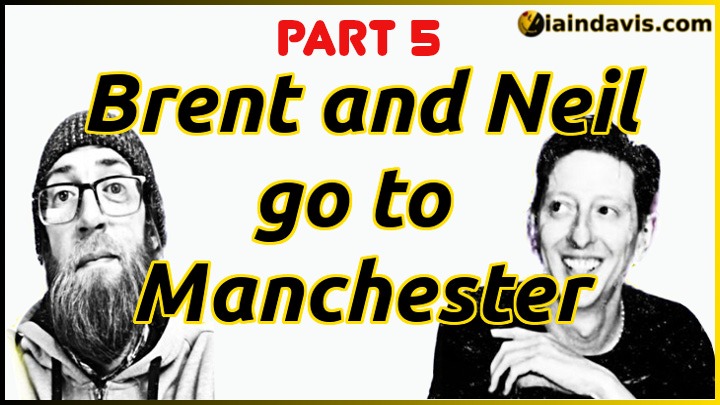
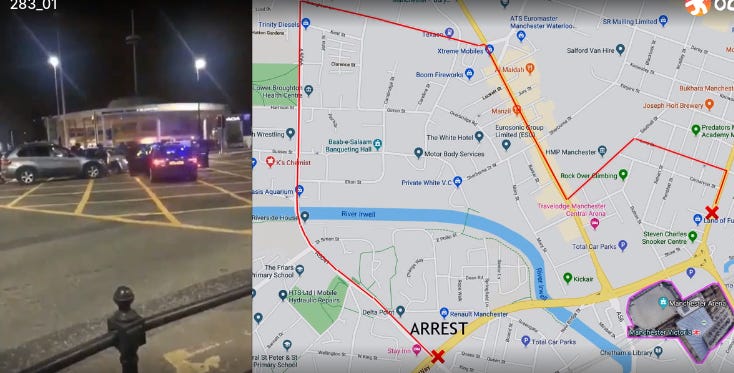

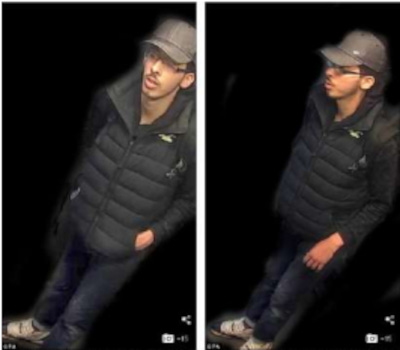
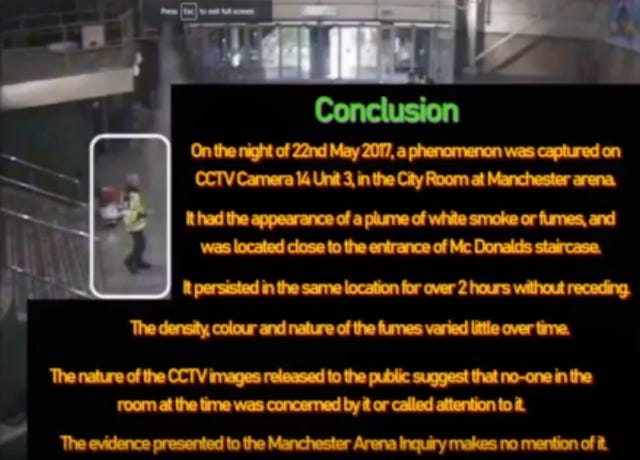
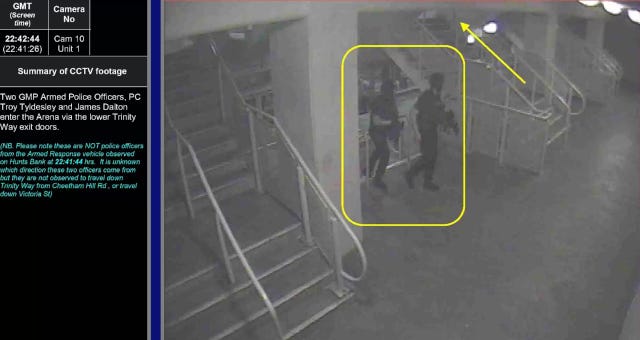
Iain, thanks for including the link to my "fumes" video. Since making the video, I've found this very interesting snippet from the Manchester Arena Investigation (MAI) testimony.
Lea Vaughan, a HART paramedic, entered the City Room (along with a colleague) at 11.15pm, which was 45 minutes post-detonation. When she gave her evidence, she said...
"We’d come over the bridge where it was very bright and we’d gone into the City Room, and it was immediately darker. And there was also quite a HAZY ATMOSPHERE FROM DUST OR SMOKE."
The barrister then asked... "did that complicate the identification of injuries and which injuries were bleeding?"
To which she replied "yes."
So, after 45 minutes, the "atmosphere" was so hazy with "dust or smoke" that it impaired visibility, and yet, she was not asked the question I would've asked... "was it dust? Or smoke?"
If it was smoke... where was it coming from? Was something smouldering? Had the fire service been informed?
If it was dust... was it causing breathing difficulties for the people in there?
It's worth noting that I've not found anyone mention discomfort experienced from inhaling smoke or dust in the City Room that night. Many have mentioned that they saw smoke, a few have mentioned a smell of fireworks or similar, but we all know how it feels to breathe in a lungful of smoke or dust - not pleasant - and some of the victims were in that room for over an hour.
Lea Vaughan was then asked...
"Would it be a good idea for you to have some sort of lighting attached to your helmets?"
A. "We did, sir . As HART operatives, we have a head torch, but I didn’t turn it on. It didn’t enter
my mind."
SIR JOHN SAUNDERS: Would it have helped if you had?
A. I wouldn’t say so because in hazy atmospheres it makes a beam, rather than lighting up the place."
So, we have a "hazy atmosphere" of "smoke or dust" in which a torch "makes a beam, rather than lighting up the place", but I have not found any reports of victims or witnesses describing breathing difficulties, choking, coughing or stinging eyes.
Any explanations? Maybe this fits the bill.
"Haze machines create a fine and subtle haze with a long ‘hang’ time – the particles linger in the air for a long time before dissipating making them ideal for use at shows and concerts. They produce a much finer and less noticeable effect than smoke or low fog machines, as they are designed to emphasize the effects of lighting allowing you to see rays and patterns you would not normally see."
https://hamiltonfilmstudios.com/shop/product/rosco-v-hazer-kit-1012